This was published 2 years ago
State of emergency declared after Sri Lankan president flees the country
By Krishan Francis and Daniel Brettig
Colombo: The Sri Lankan prime minister, acting as president after Gotabaya Rajapaksa fled the country with his wife hours before he was due to resign, has declared a state of emergency and imposed a curfew to quell protests.
Rajapaksa, his wife and two bodyguards left on Wednesday aboard a Sri Lankan Air Force plane bound for Male, the capital of the Maldives, according to an immigration official who spoke on the condition of anonymity because of the sensitivity of the situation.
As news of the flight spread, thousands of people gathered at the main protest site in Colombo chanting “Gota thief, Gota thief”, referring to him by a nickname. Hundreds of others stormed Prime Minister Ranil Wickremesinghe’s office, demanding his resignation.
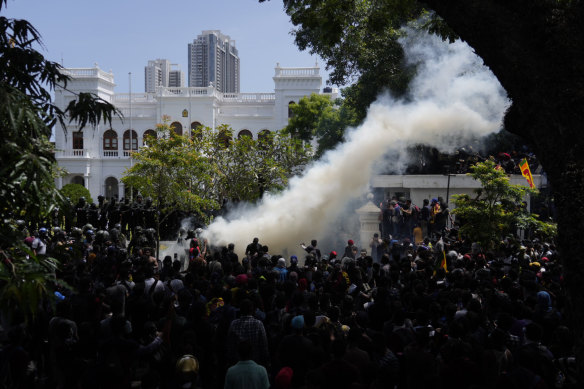
Police use teargas as Sri Lankan protesters storm the compound of prime minister Ranil Wickremesinghe’s office, demanding he resign after president Gotabaya Rajapaksa fled amid economic crisis in Colombo, Sri Lanka, on Wednesday.Credit: AP
Police fired several rounds of tear gas and a military helicopter briefly circled overhead, but the protesters appeared undeterred.
Government sources and aides said the president’s brothers, former prime minister Mahinda Rajapaksa and former finance minister Basil Rajapaksa, were still in the country.
Wickremesinghe, who on the weekend also vowed to resign once a new government was in place, imposed a curfew with immediate effect, his media secretary Dinouk Colombage said.
“The prime minister as acting president has declared a state of emergency [countrywide] and imposed a curfew in Western Province,” Colombage, told Reuters. Western Province includes Colombo.
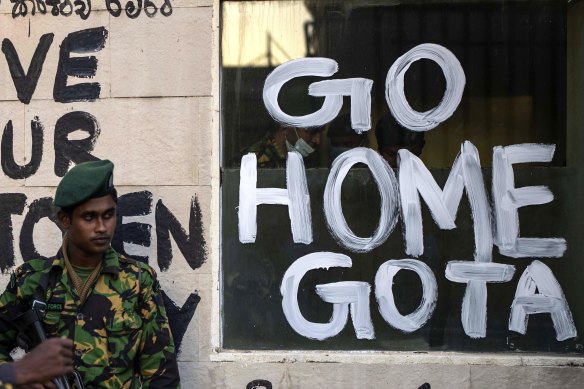
Sri Lankan soldiers patrol near the official residence of president Gotabaya Rajapaksa.Credit: AP
The speaker of parliament said Rajapaksa had approved Wickremesinghe acting as president, invoking a section of the constitution dealing with times when the president is unable to fulfil his duties.
Rajapaksa had agreed to step down under pressure and was due to formally resign his position on Wednesday.
MPs agreed to elect a new president next week but have struggled to decide on the make-up of a new government to lift the bankrupt country out of economic and political collapse.
Rajapaksa’s demise is surprising to Sri Lankans not so much for the fact it has happened, as much as for how long it has taken for the maelstrom of the nation’s economic and political issues to result in a forced resignation.
For months, opinion polls have shown as much as 90 per cent of the country’s 22 million people wanted to see him gone.
One diplomat spoken to by The Age and The Sydney Morning Herald said that in most democracies around the world, Rajapaksa would have long ago been forced out by a party spill, given the vast unpopularity of many of his decisions.
That he has not is a reflection of how tightly the Sri Lanka People’s Front (SLPP) has coalesced around the Rajapaksa family. Given this dynamic, the wider Sri Lankan population was left with no choice but to gradually increase direct pressure on the government’s leadership.
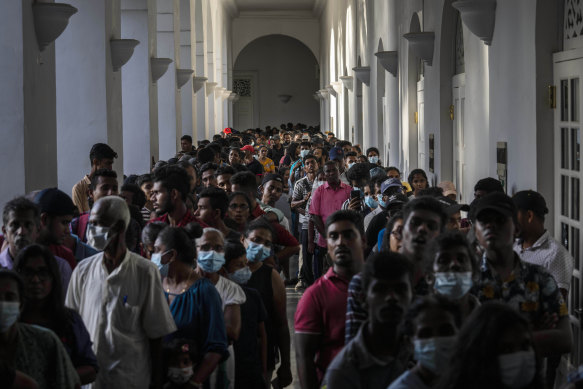
People throng President Gotabaya Rajapaksa’s official residence three days after it was stormed by anti government protesters in Colombo in Colombo, Sri Lanka, on Tuesday.Credit: AP
It’s a process that began with a massed protest outside Rajapksa’s personal residence as far back as March. All of 101 days elapsed, many of them wracked by the combination of fuel and other shortages, skyrocketing food prices and the collapse of the nation’s agriculture, before the presidential palace was finally stormed on Saturday.
That pressure had been imposed, with very rare exceptions, in a manner characterised by peaceful disobedience. The only major outbreaks of violence prior to Saturday had been initiated by pro-government forces - though the perpetrators of the fire at the private residence of Ranil Wickremesinghe on Saturday night remain unknown.
One major reason for the emphasis on non-violence is through the blood-soaked history of Sri Lanka itself. The civil war between 1983 and 2009 marked the lives and premature deaths of so many Sri Lankans - something of which those who walked into the Rajapaksa residence on Saturday were reminded.
“There was a bunker inside the Palace, which nobody knew before,” Janith Weerasinghe told The Age and The Sydney Morning Herald. “This bunker with all facilities including a gym and a lift had been built during the wartime just in case an attack happened. It was cleverly disguised and the entrance was through a wardrobe.”
Rajapaksa had not hidden there on Saturday, having fled the day before. He reportedly made numerous attempts to find sanctuary overseas, including in the United States and India.
The promised resignations brought no end to the crisis, and protesters have vowed to occupy the official buildings until the top leaders are gone. For days, people have flocked to the presidential palace almost as if it were a tourist attraction — swimming in the pool, marvelling at the paintings and lounging on the beds piled high with pillows. They also burnt the prime minister’s private home.
While MPs agreed late on Monday to elect a new president from their ranks on July 20, they have not yet decided who will take over as prime minister and fill the cabinet.
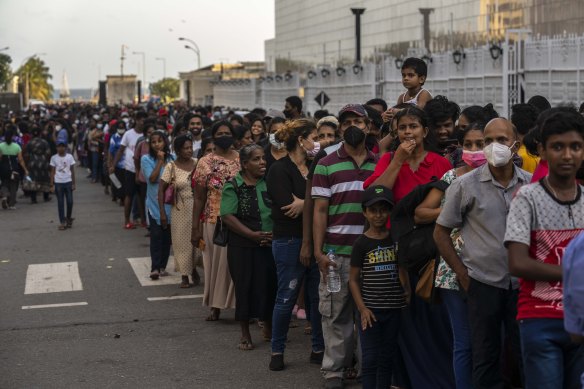
People wait in queue to enter the official residence of president Gotabaya Rajapaksa three days after it was stormed by anti-government protesters in Colombo.Credit: AP
The new president will serve the remainder of Rajapaksa’s term, which ends in 2024 — and could potentially appoint a new prime minister, who would then have to be approved by parliament.
The prime minster is to serve as president until a replacement is chosen — an arrangement that is sure to further anger protesters who want Wickremesinghe out immediately.
Corruption and mismanagement have left the island nation laden with debt and unable to pay for imports of basic necessities. The shortages have sown despair among the country’s 22 million people. Sri Lankans are skipping meals and lining up for hours to try to buy scarce fuel.
Until the latest crisis deepened, the Sri Lankan economy had been expanding and growing a comfortable middle class.
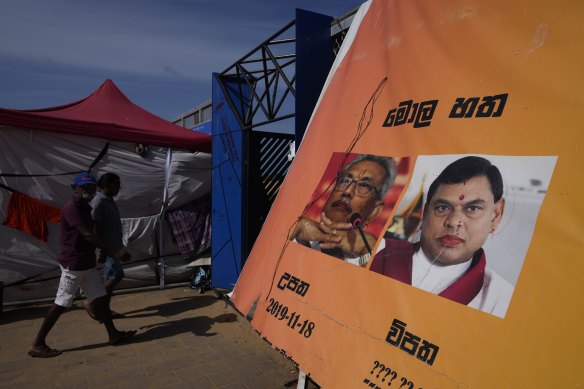
People walk past a poster showing defaced portraits of president Gotabaya Rajapaksa and his brother Basil.Credit: AP
The political impasse added fuel to the economic crisis since the absence of an alternative unity government threatened to delay a hoped-for bailout from the International Monetary Fund. The government must submit a plan on debt sustainability to the IMF in August before reaching an agreement.
In the meantime, the country is relying on aid from neighbouring India and from China.
Asked whether China was in talks with Sri Lanka about possible loans, a Chinese Foreign Ministry official gave no indication whether such discussions were happening.
“China will continue to offer assistance as our capability allows for Sri Lanka’s social development and economic recovery,” said the spokesman, Wang Wenbin.
On Tuesday, Sri Lanka’s religious leaders urged protesters to leave the government buildings. The protesters have vowed to wait until both Rajapaksa and Wickremesinghe are out of office.
After the storming of the government buildings, “it was clear there is a consensus in the country that the government leadership should change,” said Jehan Perera, executive director of the National Peace Council of Sri Lanka, a think tank.
Months of demonstrations have all but dismantled the Rajapaksa political dynasty, which has ruled Sri Lanka for most of the past two decades.
The protesters accuse the president and his relatives of siphoning money from government coffers for years and Rajapaksa’s administration of hastening the country’s collapse by mismanaging the economy. The family has denied the corruption allegations, but Rajakpaksa acknowledged some of his policies contributed to the meltdown.
The president had not been seen nor heard from since Saturday, though his office issued statements indicating that he continued to carry out his duties.
AP, Reuters, with Daniel Brettig